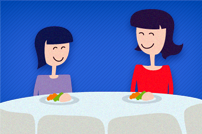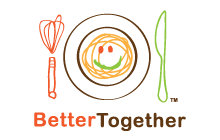Learning to Eat Takes Practice
August 25, 2011
It's true, learning to eat takes practice. So many parents worry about their "picky eaters" and wonder how to deal (we've heard from many of you!) so when we came across the following article by Cathy Richards, a Community Nutritionist for Interior Health, we asked her if we could share her wisdom here! Enjoy!
_ _ _
Learning to Eat Takes Practice (By Cathy Richards)
Kids get a bad rap when it comes to eating. Over the years, I’d bet a thousand parents have said to me “my child is such a picky eater!” My response? “Oh, that’s so normal!” Picky eaters are a dime-a-dozen. I call them eaters-in-training. Like Mozart being able to compose a symphony at the age of 4, a child who readily tries and loves all foods is an eating-protégé. All other children are normal!
Think about it. If your child was in piano lessons, would you expect them to play a sonata after 1 or 2 lessons? If your child was in soccer, would you expect them to score a goal in their first game? Learning takes time. Eating is no different.
Patterned, Repetitive Experiences.
I recently heard a Child Psychiatrist speak about learning. He showed how children’s brains make connections between different cells, and how “patterned, repetitive experiences” were needed for the brain to remember a new skill.
Fingers on piano keys. Feet kicking a ball. We help our kids practice these things over and over. We keep practice pleasant, we don't expect a lot, and we praise them for every positive effort even if they play a wrong note or miss the ball.
This is exactly what children need from you to learn to eat well.
Research shows that it takes 15-20 exposures to a food before most kids will accept it. A pleasant atmosphere with no expectations speeds up this process.
A child who is presented with a new food, or a familiar food served a different way, has a lot to learn before they feel comfortable putting it in their mouth and swallowing.
First, they want to look at it. What colour is it? Is it smooth or chunky? Does it look like anything they’ve seen before? Their busy brains have to process all this.
Then they need to see how you eat it. Do you cut it? Do you have to chew a lot? Do you look happy eating it? Their brains process this, too.
Then they want to know what it feels like. A poke with their fork, then their finger (so much better than a fork!), and maybe they’ll touch it to their lips. Busy busy brain.
It might take 4 or more meals for a child to get this far in the learning-to-eat process. With a seasonal food like asparagus, this could take about 2 years! And they still haven’t eaten it! But this is normal.
The next step, putting the food in their mouth, is a giant step.
I say things like “this is a food for days when you’re feeling adventurous”, or “it’s an adult food”. Kids love to be adventurous and grown up!
Kids need to feel relaxed and safe to learn best, so your choice of words is important.
Kids respond better to “see what you think”, rather than “try it”. This lets them explore without having to use their mouth. It also prevents them from digging in their heels to prove you wrong: “gross, I told you I’d hate it”.
Here’s one way to present a new food: “It tastes sort of like ____ and feels sort of _____. See what you think. If you don’t want to swallow, use your napkin to politely put the food in”. This gives them a sense of safety. Imagine yourself going out on a bridge and then deciding you don’t want to bungie jump after all. You’d never even get on the bridge if you knew there was no way out!
Then say “It’s okay if you don’t want to finish, it’s just great that you explored a little” instead of “Oh, you don’t like it”. You want them to feel good about their eating skills, and to explore the food again next time you serve it.
Give your kids repetitive exposure to a wide variety of food in a pleasant atmosphere. Set a good example. Let them explore within their comfort zone. Praise them for exploring. Be patient while their brains make permanent connections around learning to eat.
Your eater-in-training will become a real eater in no time. Well, maybe in 2 to 15 years. But that’s normal!
_ _ _
A big thanks to Cathy for letting us share her take on picky eaters. Cathy says the important thing for parents to remember is that although the family meal is centered around eating, eating isn’t the most important thing that is happening. The most important thing is connecting, talking, learning about life and food. So true! We hope you enjoyed this and invite you to continue the converation here!

















(1) Comment
Kristen Yarker
August 25, 2011 at 8:45 PM
So true Cathy, so true!
I particularly like your advice about what to say to encourage picky eaters to try things (and feel good about trying things).
Kristen
.(JavaScript must be enabled to view this email address)